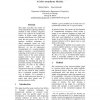Free Online Productivity Tools
i2Speak
i2Symbol
i2OCR
iTex2Img
iWeb2Print
iWeb2Shot
i2Type
iPdf2Split
iPdf2Merge
i2Bopomofo
i2Arabic
i2Style
i2Image
i2PDF
iLatex2Rtf
Sci2ools
CORR
2002
Springer
2002
Springer
Using eigenvectors of the bigram graph to infer morpheme identity
This paper describes the results of some experiments exploring statistical methods to infer syntactic categories from a raw corpus in an unsupervised fashion. It shares certain points in common with Brown et at (1992) and work that has grown out of that: it employs statistical techniques to derive categories based on what words occur adjacent to a given word. However, we use an eigenvector decomposition of a nearest-neighbor graph to produce a two-dimensional rendering of the words of a corpus in which words of the same syntactic category tend to form clusters and neighborhoods. We exploit this technique for extending the value of automatic learning of morphology. In particular, we look at the suffixes derived from a corpus by unsupervised learning of morphology, and we ask which of these suffixes have a consistent syntactic function (e.g., in English, -ed is primarily a mark of verbal past tense, does but
| Added | 18 Dec 2010 |
| Updated | 18 Dec 2010 |
| Type | Journal |
| Year | 2002 |
| Where | CORR |
| Authors | Mikhail Belkin, John A. Goldsmith |
Comments (0)

